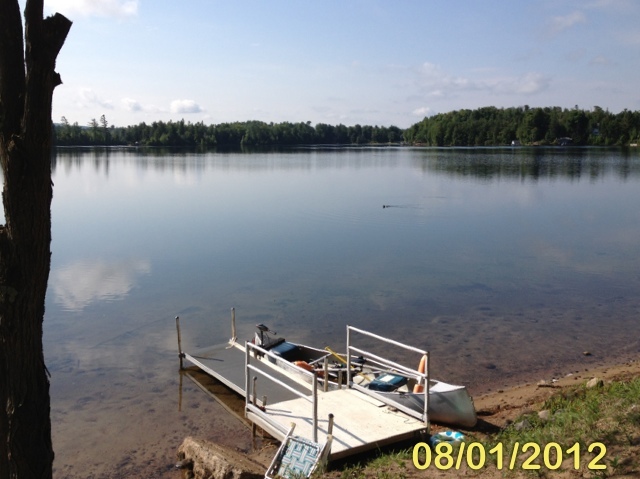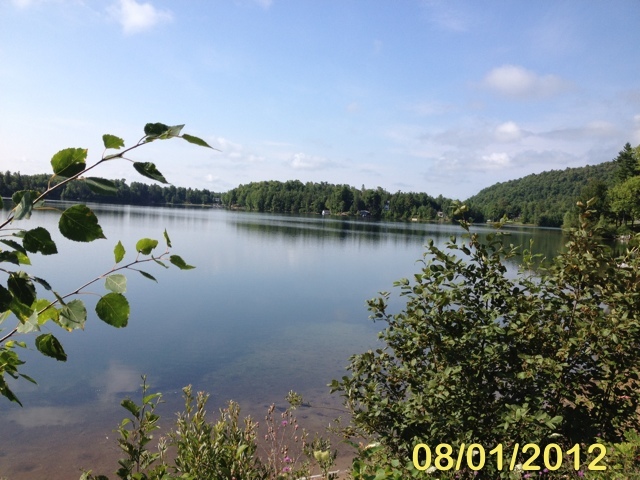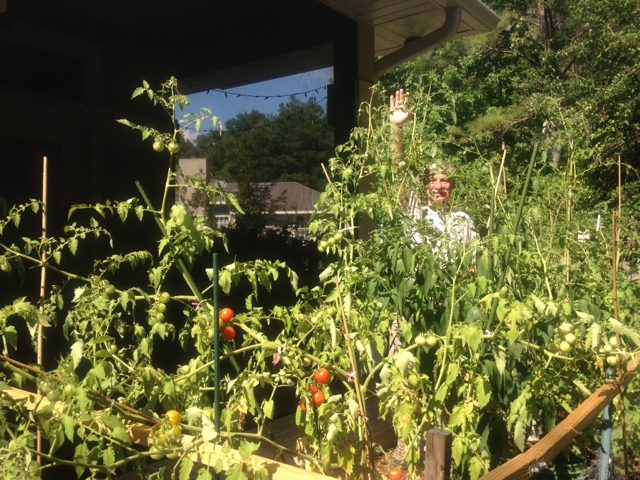Friday, December 21, 2012
Spring Peepers
Last night a cold front was approaching, and we heard peepers calling in the back yard. They begin calling in December in most years, and 2012 will be no exception.
The photo was taken near our home in Gainesville on September 4, 2012.
Sunday, December 16, 2012
Sunday, December 2, 2012
Fall Grapevines
Florida Grapes - this vine is growing on our fence in Cedar Key
Muscadines - this vine is growing less than a meter from the Florida grapes shown above.
Grapevines love it here in the scrub. Both species are vigorous growers, and it is difficult to say definitively which one is dominant. Perhaps muscadines grow better in moist woods.
Monday, November 26, 2012
Fall in Florida
Heavy frost yesterday morning and again overnight.
And the hollies are dressing up the season. Yaupon above and dahoon below.
And the hollies are dressing up the season. Yaupon above and dahoon below.
Wednesday, November 14, 2012
Wednesday, August 1, 2012
We Are in Star Lake
Spaghetti and key lime pie with neighbors for our first night at the Lake. Can't beat that!
Windows open. Breeze blowing in for sleeping.
Sunshine and 70 degrees for our walk around the lake this morning. 4 miles and some hills.
Very nice start to our stay with one big negative...poor Jake seems to be having trouble recovering the strength in his back legs after such a long ride on the car.
Windows open. Breeze blowing in for sleeping.
Sunshine and 70 degrees for our walk around the lake this morning. 4 miles and some hills.
Very nice start to our stay with one big negative...poor Jake seems to be having trouble recovering the strength in his back legs after such a long ride on the car.
Wednesday, July 25, 2012
Buttonbush
Buttonbush (Cephalanthus occidentalis) plants seem to be flowering abundantly this year, although until this one, I've had trouble getting a good photo of one.
Tuesday, July 17, 2012
Lots of Deer This Year
This photo, taken through the screen on our back porch, shows a doe and what appear to be twin fawns. At least one other doe, this with a single fawn, shows up with them sometimes. For the most part they are quite tame. Our dog pays them little heed, and they aren't intimidated by him. One possible reason they have been hanging out in our lawns is to get out of the woods and away from the mosquitoes, which have been very bad since Tropical Storm Debby.
Saturday, June 23, 2012
Florida Maple
Florida Maple is one of our more interesting plants here in the north central part of the state. Some botanists consider it a subspecies or variety of the sugar maple (Acer saccharum...variety floridanum), while others consider it a separate species (Acer barbatum or Acer floridanum, the two names only adding to the confusion).
A reminder: sugar maple is the source of that stylized red leaf adorning the national flag of Canada.
So what are trees so dominating much of Canada that they are considered the symbol of the nation doing in Florida? One thing they are doing differently here is generally growing in the understory, rather than as the dominant tree in the upper canopy, as in much of the north. We've seen fairly large specimens in San Felasco Hammock State Preserve, but never so tall that they over-top other species.
One possible answer may lie in their ecological specialization. The one thing these trees do better than almost any other is tolerate shade. For this they pay a price, because nearly all the adaptations for tolerating shade tend to make trees poorer at conserving water. In the north (in the Adirondacks and much of northeastern and north central U.S., as well as in Canada) where it is cool and moist they can use their shade tolerance, enabling them to shade out competitors and dominate the forest canopy. Here in the Florida peninsula, however, they require the shade, humidity, and soil moisture retention of rich woods where other tree species help them avoid excessive moisture loss.
Any other suggested answers will be welcome.
Friday, June 22, 2012
Showy Native Plants
Two plants in our backyard are natives that are showy and good for landscaping.
Coral honeysuckle (Lonicera sempervirens) is a vine with red flowers that are especially attractive to hummingbirds. It is difficult to imagine flowers better adapted to the long beaks and narrow tongues of nectar-seeking hummingbirds. New plants spring up frequently in other parts of the yard, and it seems likely that the hummers are responsible for dispersal of seeds.
Beautyberry (Calicarpa americana) also shows up frequently as a volunteer, as is the case of this one. The lavender flowers are small and relatively inconspicuous, but they are replaced later in the season by vivid purple-red berries. For this plant, it is probably berry-eating birds that are responsible for dispersal.
Wednesday, May 23, 2012
Thursday, May 17, 2012
Needle Palms and Other Palms
On Monday's walk in the San Felasco Hammock State Preserve, we spotted along the Creek Sink Trail what is almost certainly a needle palm. In the photos above you see a plant without the upright or prostrate stem, evident most other (but not all) local palms, and shiny dark green leaves not seen in saw palmettos. It has true palmate fronds, unlike cabbage palms. We also saw what we believe are dwarf palmettos. We'll have to investigate further, but believe they differ in subtle ways from the scrub palmettos that grow all around our house. We would appreciate any comments or corrections from those who know their palms better than we do.
Friday, April 20, 2012
A Skink
Here's a small skink seen on our deck this afternoon. S(h)e was pretty, colorful, and remarkably tame.
Interestingly, this individual may represent one of three remarkably similar species--so called sibling species. This one could conceivably be the eastern five-lined skink (Eumeces fasciatus), the broad-headed skink (Eumeces laticeps), or the southeastern five-lined skink (Eumeces inexpectatus). The last was named by taxonomist E. H. Taylor, who never expected until his technical investigations discovered it that another species was lurking in this complex of similar-looking lizards.
We suspect that this one is laticeps, based not on counting scale rows or similar taxonomic indicators, but rather on the other lizards we see around us.
Thursday, April 12, 2012
A Termite Hatch
Monday, March 12, 2012
Snakes Alive!
We seldom see snakes on our walks around Gainesville, although at widely spaced intervals in the past those we have seen have included potentially dangerous cottonmouths and coral snakes--not always welcome sightings close to home.
On our walk today we were fortunate to see two different kinds of snakes of the non-venomous variety.
This one, a black racer Coluber constrictor priapus, is quite common. We see them occasionally in the yard, although they usually flee quickly when you approach them. We had one chance to photograph this one before he slithered off in great haste.
This one, also common, is either the bluestripe garter snake, Thamnophis sirtalis similis, or the eastern garter snake, Thamnophis sirtalis sirtalis. The bluestripe occurs in Florida's Big Bend region, and ours in Gainesville are probably a blend of the more common and Big Bend varieties. Unlike the racer, this snake seemed willing to pose all day for us, and we got several good photos.
Wednesday, January 25, 2012
Fall and Spring in Florida
Two images of the same tree, a red maple in our yard in Cedar Key on January 24, 2012. The upper shows its fall colors and the lower its spring flowers. Winter is short in Florida!
Saturday, January 7, 2012
Wanakena
| Packbasket Adventures Lodge in Wanakena, NY |
The failure of the enterprise raises questions about the future of Wanakena as a resort destination. Surely the public agencies that helped get start-up funding envisioned the lodge as the core of a revitalized community. However, one lodging doesn't a vacation community make, and to our knowledge there has been no movement toward developing other visitor-friendly amenities, let alone lodging options.
The evolution of Wanakena has taken it first from a company town developed for logging, to a resort enjoying a brief heyday, to a bedroom community providing needed housing for the nearby iron mine and paper mill, to a quiet backwater. Perhaps its best and highest future is to remain a quiet backwater.
Subscribe to:
Posts (Atom)







